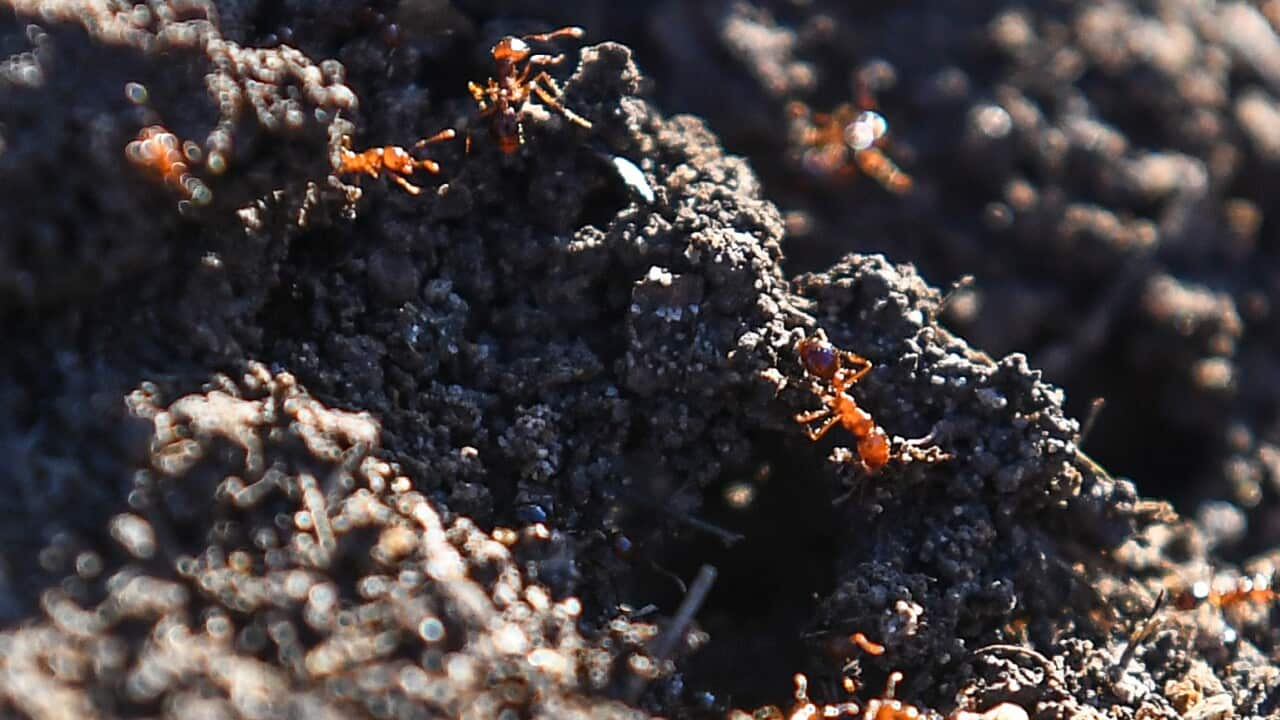Key Points
- Fire ants could be spreading, experts have warned.
- The government has committed more money to control fire ants.
- But some say the money is inadequate.
Fire ants could be spreading across Australia and presenting a serious threat to people and agriculture, experts have warned.
But what are fire ants, where are they and why are they so dangerous?
How to identify fire ants
Principal research scientist at the CSIRO Dr Ben Hoffman told SBS News only two species have spread beyond the Americas.
"Fire ants are a bunch of species in the gene of sololonopsis that are native to the Americas, mostly in South America, and they have very powerful stings, which anyone that comes across them would know about," he said.

As well as posing environmental and economic threats, fire ants can be deadly to humans and animals. Source: AAP / SUPPLIED/PR IMAGE
Fire ant colonies contain 200,000 to 400,000 workers, although some form vast super-colonies made up of many interconnected nests, with millions of workers.
Where are fire ants in Australia?
Red fire ants are contained in zones in eastern Queensland, but are likely to spread beyond those areas, the council says.
Federal agriculture minister Murray Watt said fire ants were “a very real threat” to south-east Queensland and that states were united on the need to act.
Hoffman has been part of a science advisory group to the National Fire Ant Eradication Program, and says he believes the program has been fairly successful.
However, the program's latest report found that if the national cost-shared program wound down, the spread of the fire ants in Australia is likely to mirror that in the United States, where the ants are virtually uncontained.

A fire ant nest at a farm in Queensland. Fire ant colonies contain 200,000 to 400,000 workers. Source: AAP / Jono Searle
"We certainly know that fire ants can be eradicated, there's plenty of precedents, so technically feasible," he said.
"This is probably the largest potential eradication of an ant in the world, so we're really pushing the limits here of what can be achieved whit the resources available."
Why are fire ants so dangerous?
As well as posing environmental and economic threats, fire ants can be deadly to humans and animals.
They are omnivores able to attack animals and eat plants.
They are highly aggressive and use a venomous sting to kill their prey and will swarm in large numbers to attack anything disturbing their nest.
What happens if you get bitten by a fire ant?
Fire ant stings are painful and can be accompanied by burning or itching that can last up to an hour, according to Western Australia's health department.
Applying a cold compress to relieve swelling and pain, and washing skin with soap and water could help, the department says.
While Australia has not yet reported a fire-ant-related death, the Invasive Species Council note there have been 85 reported deaths in the United States from anaphylactic shock.
Symptoms of anaphylactic shock include skin reactions such as hives, constriction of the airways and difficulty breathing, low blood pressure and dizziness and fainting.
Hoffman says it's a worry for Australia if the ants continue to spread.
"We do know from the science from around the world, that 3 per cent of the population anywhere, will have a very high reaction to fire ants, which typically means anaphylactic shock and hospitalisation, and it's those people who are at risk of death," he said.
"They're called fire ants for a reason, because they burn like fire, you really want to avoid them."
Has the government delayed responding to the fire ants threat?
Watt said he expected up to $60 million more would be spent up to June 2024 fighting fire ants.
However a recent Biosecurity Queensland report found an extra $593 million was needed for the national eradication plan.
A separate review of the eradication strategy found at least $3 billion would be needed over the next five years.

Red fire ants are contained in zones in NSW and eastern Queensland, but are likely to spread beyond those areas. Source: AAP, AP / Kenneth G. Ross
“[The] delay of this decision means we expect fire ants will breach containment into NSW and western Queensland,” Pianta said.
“The government has had two years to act on this critical issue. There are no excuses and inaction makes this situation worse.
He said the inadequate amount of funding "risks the work that has been done so far on fire ants and puts all of Australia in danger.”
How did fire ants get to Australia?
Hoffman said it's difficult to track exactly how the ants travelled all the way to Australia from their native South America.
But he says it's unsurprising that they have made it to Australia, with ants being found travelling long distances on yachts, and even jumping off planes after being in cargo.
"Ants are incredibly good at being hitch-hikers, which is why we now have so many exotic ant species in places all around the world," he said.
"There's nothing really deliberate in all this, they just end up in goods that we transport."
"There was a couple of incursions in particular in Queensland, where the ants were associated with equipment that had been manufactured in the likes of Texas for a refinery construction, and they were in that somehow."
With additional reporting by the Australian Associated Press.









